grat
Member
I really shouldn't be allowed on the internet. I keep finding strange, obscure cameras that tickle a fancy.
The latest is a very good condition Houghton Klito No. 3 "Falling Plate" camera.
For those not familiar, this is a "Detective" camera, also known as a "falling plate" or "hand" camera. "Hand" because at a mindbogglingly fast f/8 aperture, the camera could (theoretically) be handheld. Falling plate because as you expose each plate, you toggle the switch on top, and the exposed plate falls to the bottom of the camera. Detective because of a misplaced belief that Detectives used concealed, or "unremarkable" cameras. Basically, it was a street camera in it's day.
Entertainingly, apparently "hand" cameras were somewhat controversial when they debuted, with some scoffing and claiming they weren't "real" cameras. Good thing it's different now.
This particular model is very sophisticated, having adjustable aperture, a shutter mechanism that can be re-calibrated, a Beck f/8 "Symmetrical" lens, an exposure counter on top, and a distance gauge on the side. You could also open just the lower compartment and remove exposed plates.
Unlike a typical box camera with a fixed lens, you could adjust focus on this one-- turn the knob on the side to rack the front part of the camera in and out until you had the distance right in the gauge, and then compose either portrait or landscape through the finders.
It even has a yellow slide-in filter inside the front door, so you can take photos with a filter if you wish.
This particular example is 100% complete, and nearly as functional. I'm missing 5 of the plate holders (3¼ x 4¼, or "quarter plate" size), but 7 is sufficient. There's remarkably little corrosion present, except for one or two magazines, and some patina/crud on some of the brass. Manufacturer's catalog claim it can take 12 plates or 24 sheets of film, but I have not even even seen one sheet film septum, let alone a couple dozen. I might try manufacturing some, either 3D printed, or from actual sheet metal. It came with one (heavily exposed) plate from who knows when.
The shutter fires either Very Fast, or Very Slow. The "internal" optics (rear element of the lens, the mirrors for the finders, the inside of the finder lenses) are all very dirty, and need cleaning. The outside optics (front lens element, outside lens surfaces for the finders) are pretty clean. Overall, it appears someone maintained the camera reasonably well for the last century.
Some of the magazines are bent enough to cause problems with the falling mechanism-- which is basically a large coil spring (#3) that presses against the back of the magazines. Each magazine is either a "1" or a "2"-- and they have notches in the top, slightly offset from each other. You load the magazine in alternating order, then when you flip the switch on top to one side, it release the "#1" plate, which is pushed to the end of the rails (they're curved), pivots forward, falls, and stacks up on the bottom. Flip the switch to "#2", and the next plate drops. There's a difficult to read frame counter that counts up to 24, and advances with each flip of the switch.
Air displacement cushions the fall, and there are some springs to push the plates back against the wooden wedge on the bottom door flap, to keep them from bouncing around.
The cameras were made from around 1905 to around 1919, and one catalog I found suggested it was priced at $63 USD. All in all, a really fascinating bit of camera-- I'm hoping to restore it to fully functional condition, and take some photos with it. Anyone have advice for disassembly?
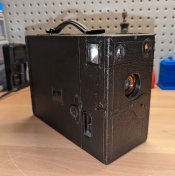
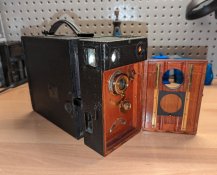
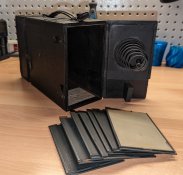
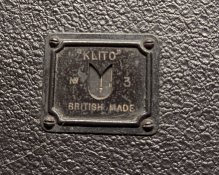
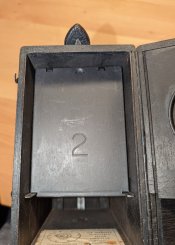
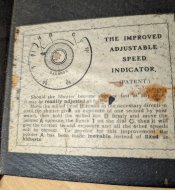
The latest is a very good condition Houghton Klito No. 3 "Falling Plate" camera.
For those not familiar, this is a "Detective" camera, also known as a "falling plate" or "hand" camera. "Hand" because at a mindbogglingly fast f/8 aperture, the camera could (theoretically) be handheld. Falling plate because as you expose each plate, you toggle the switch on top, and the exposed plate falls to the bottom of the camera. Detective because of a misplaced belief that Detectives used concealed, or "unremarkable" cameras. Basically, it was a street camera in it's day.
Entertainingly, apparently "hand" cameras were somewhat controversial when they debuted, with some scoffing and claiming they weren't "real" cameras. Good thing it's different now.

This particular model is very sophisticated, having adjustable aperture, a shutter mechanism that can be re-calibrated, a Beck f/8 "Symmetrical" lens, an exposure counter on top, and a distance gauge on the side. You could also open just the lower compartment and remove exposed plates.
Unlike a typical box camera with a fixed lens, you could adjust focus on this one-- turn the knob on the side to rack the front part of the camera in and out until you had the distance right in the gauge, and then compose either portrait or landscape through the finders.
It even has a yellow slide-in filter inside the front door, so you can take photos with a filter if you wish.
This particular example is 100% complete, and nearly as functional. I'm missing 5 of the plate holders (3¼ x 4¼, or "quarter plate" size), but 7 is sufficient. There's remarkably little corrosion present, except for one or two magazines, and some patina/crud on some of the brass. Manufacturer's catalog claim it can take 12 plates or 24 sheets of film, but I have not even even seen one sheet film septum, let alone a couple dozen. I might try manufacturing some, either 3D printed, or from actual sheet metal. It came with one (heavily exposed) plate from who knows when.
The shutter fires either Very Fast, or Very Slow. The "internal" optics (rear element of the lens, the mirrors for the finders, the inside of the finder lenses) are all very dirty, and need cleaning. The outside optics (front lens element, outside lens surfaces for the finders) are pretty clean. Overall, it appears someone maintained the camera reasonably well for the last century.
Some of the magazines are bent enough to cause problems with the falling mechanism-- which is basically a large coil spring (#3) that presses against the back of the magazines. Each magazine is either a "1" or a "2"-- and they have notches in the top, slightly offset from each other. You load the magazine in alternating order, then when you flip the switch on top to one side, it release the "#1" plate, which is pushed to the end of the rails (they're curved), pivots forward, falls, and stacks up on the bottom. Flip the switch to "#2", and the next plate drops. There's a difficult to read frame counter that counts up to 24, and advances with each flip of the switch.
Air displacement cushions the fall, and there are some springs to push the plates back against the wooden wedge on the bottom door flap, to keep them from bouncing around.
The cameras were made from around 1905 to around 1919, and one catalog I found suggested it was priced at $63 USD. All in all, a really fascinating bit of camera-- I'm hoping to restore it to fully functional condition, and take some photos with it. Anyone have advice for disassembly?


















